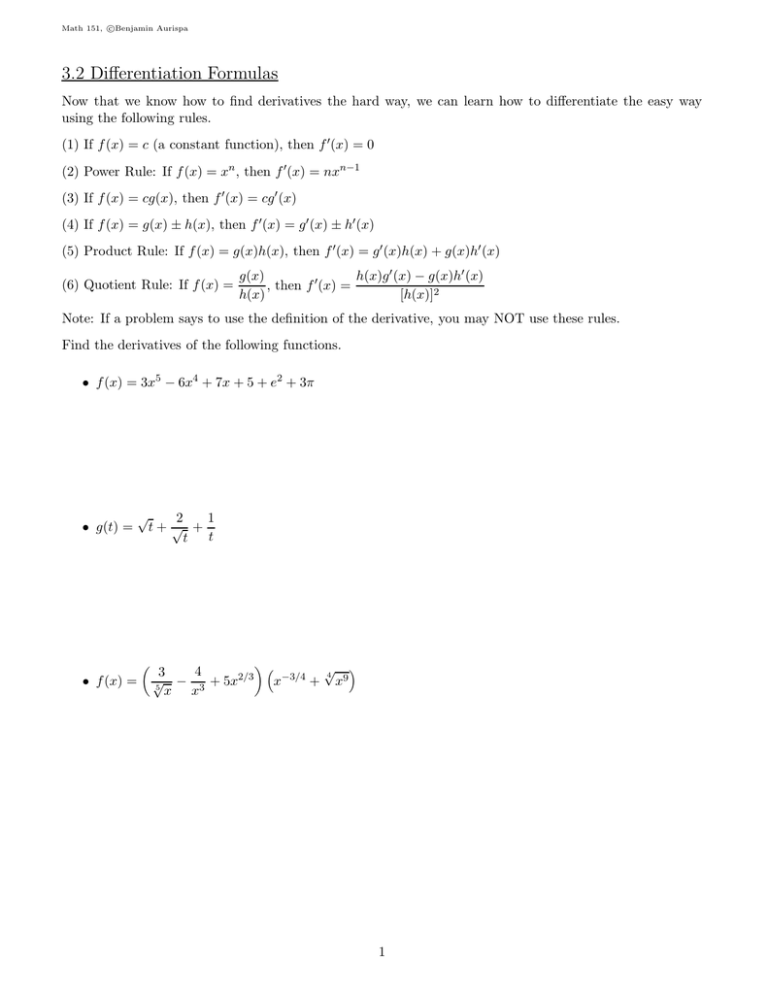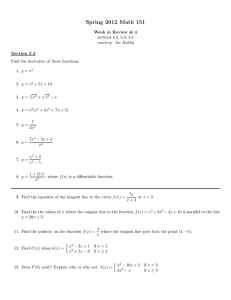Document 10504184
advertisement

c Math 151, Benjamin Aurispa 3.2 Differentiation Formulas Now that we know how to find derivatives the hard way, we can learn how to differentiate the easy way using the following rules. (1) If f (x) = c (a constant function), then f ′ (x) = 0 (2) Power Rule: If f (x) = xn , then f ′ (x) = nxn−1 (3) If f (x) = cg(x), then f ′ (x) = cg ′ (x) (4) If f (x) = g(x) ± h(x), then f ′ (x) = g ′ (x) ± h′ (x) (5) Product Rule: If f (x) = g(x)h(x), then f ′ (x) = g ′ (x)h(x) + g(x)h′ (x) (6) Quotient Rule: If f (x) = g(x) h(x)g ′ (x) − g(x)h′ (x) , then f ′ (x) = h(x) [h(x)]2 Note: If a problem says to use the definition of the derivative, you may NOT use these rules. Find the derivatives of the following functions. • f (x) = 3x5 − 6x4 + 7x + 5 + e2 + 3π • g(t) = √ 2 1 t+ √ + t t • f (x) = √ 4 3 4 2/3 −3/4 9 √ − + 5x x + x 5 x x3 1 c Math 151, Benjamin Aurispa • g(s) = s3 + s s2 − 3 √ t3 − 3t2 + t t √ • g(t) = t √ 1 Example: An object moving in a straight line has position function f (t) = 2 − 2t3 − 8t t where position 5t is measured in meters and time is measured in seconds. Find the velocity at time t = 1. Example: Consider the function f (x) = x3 − 3x2 − 9x + 1. For what values of x does f (x) have a horizontal tangent? 2 c Math 151, Benjamin Aurispa Example: Find an equation of the tangent line to the graph of g(x) = Example: Suppose h(x) = f (x)g(x) and u(x) = f (x) , where the graphs of f and g are given below. Find g(x) the following. (a) h′ (3) (b) u′ (1) (c) Find a formula for k′ (x) if k(x) = 3x at x = 2. x2 − 1 (3x + 1)2 f (x) 2g(x) 3 c Math 151, Benjamin Aurispa Example: For what values of a and b is the line y = −3x + b tangent to the graph of f (x) = ax3 when x = −2? Example: Find the equations of both tangent lines to the curve y = x2 + 3x that also pass through the point (−1, −6). 4 c Math 151, Benjamin Aurispa Example: Where is the function f (x) = x1/3 not differentiable? Example: Where is the function f (x) = |3x + 7| not differentiable? What is f ′ (x)? Example: Where is the function below not differentiable? Find f ′ (x). f (x) = −2x − 1 x2 3x − 2 2 x − 5x if if if if x < −1 −1≤x≤2 2<x<4 x≥4 5 c Math 151, Benjamin Aurispa For what values of b and c is the following function differentiable everywhere? f (x) = ( x2 bx3 + c if x ≤ 2 if x > 2 3.3 Rates of Change in the Natural and Social Sciences An object is thrown vertically upward with a velocity of 40 ft/s. Its height after t seconds is given by s(t) = 40t − 16t2 + 24. • What is the maximum height achieved by the object? • What is the object’s velocity when it is at a height of 40 ft on its way down? • With what velocity does the object hit the ground? 6 c Math 151, Benjamin Aurispa A particle moves according to the position function s(t) = 2t3 − 12t2 + 18t + 3, for t ≥ 0 where t is measured in seconds and s is measured in feet. • When is the particle at rest? • When is the particle moving in the positive direction? negative direction? • Find the total distance traveled in the first 5 seconds. 7 c Math 151, Benjamin Aurispa Suppose a spherical balloon is being blown up so that its radius is increasing at the rate of 2 cm/s. This means its radius after t seconds is r = 2t cm. • Find the rate at which the volume of the sphere is changing with respect to the radius when the radius is 3 cm. • Find the rate at which the volume is increasing after 3 seconds. Note: The volume of a sphere is V = 34 πr 3 . 3.4 Derivatives of Trig Functions Important Limits: sin x =1 x→0 x cos x − 1 =0 x→0 x lim lim Given these limits as facts, the following must also be true: lim x→0 Calculate the following limits. sin 5x x→0 x • lim sin 7x x→0 sin 6x • lim sin 4θ θ→0 3θ cos 7θ • lim 8 ax sin ax = 1 and lim =1 x→0 sin ax ax c Math 151, Benjamin Aurispa • lim sin 3t 4 cos 2t • lim cos x − 1 sin 3x t→0 x→0 sin t t→0 tan 2t • lim x2 x→0 tan2 8x • lim Derivatives of the Trig Functions: d dx sin x = cos x d dx csc x = − csc x cot x d dx cos x = − sin x d dx sec x = sec x tan x d dx tan x = sec2 x d dx cot x = − csc2 x Calculate the derivatives of the following functions. • f (x) = cos x + 2 sec x • g(t) = 4t − tan t sin t 9 c Math 151, Benjamin Aurispa √ 3 θ cot θ • h(θ) = csc θ + θ 2 Find the equation of the tangent line to the graph of y = 2 sin x − 3 at the point where x = π6 . For what values of x, 0 ≤ x < 2π, does the graph of f (x) = 10 sin x have a horizontal tangent. 2 + cos x





